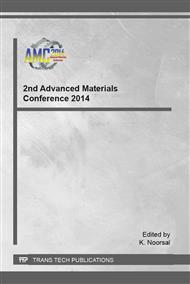p.156
p.161
p.166
p.171
p.175
p.180
p.185
p.191
p.196
Chemical Reaction and Morphology of Polypropylene (PP)/Recycled Acrylonitrile Butadiene Rubber (NBRr)/Banana Skin Powder (BSP) Composites with γ-APS
Abstract:
Polypropylene (PP)/ recycled acrylonitrile butadiene rubber (NBRr)/ banana skin powder (BSP) composites were studied. Different BSP filer loading (5, 10, 15,20,25,30 wt. %) were prepared by using heated two roll mill at 180 °C. Then, the composites were tested for functional group using FTIR model Perkin Elmer Series 2. Field Emission Scanning Electron Microscope (VPFESEM) model Zeiss SUPRA 35VP also were using for morphological study. The effect of 3-aminopropyltrimethoxysilane (APS) as coupling agent were evaluated.The FTIR test shows different bands around 3200-3500 and 1740 cm-1 which represent the stretching of OH and C=O groups respectively. As for BSP which composed mostly of cellulose, hemicelluloses and lignin, the cellulose backbone C-OH is represent by the peaks of 1050 and 1048 cm-1 respectively. The γ-APS intense band around 1167 cm-1 and 1098 cm-1 in treated composite was assigned to the stretching of the-Si-O-Cellulose and –Si-O-Si-bond respectively. The large band around 1050 cm-1 found on BSP filler was attribute to the –Si-OH group which later this band will disappear after the surface modification. This evidenced that bonding between γ-APS treated BSP with PP/NBRr matrices. Morphological study supported this finding which BSP filler treated with γ-APS has improved the adhesion between BSP filler and PP/NBRr matrices.
Info:
Periodical:
Pages:
175-179
Citation:
Online since:
January 2016
Price:
Сopyright:
© 2016 Trans Tech Publications Ltd. All Rights Reserved
Share:
Citation:


